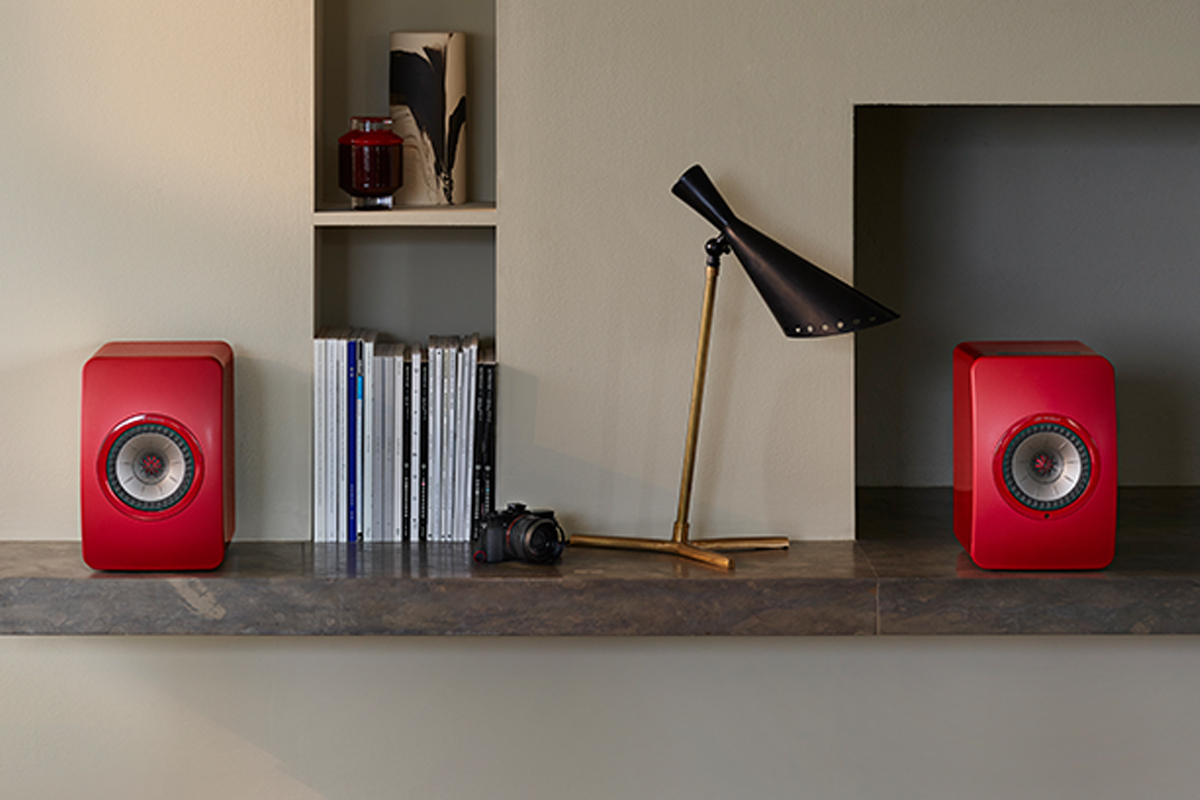 In the 21st century, has there been a more successful, more important bookshelf loudspeaker than KEF’s LS50? I doubt it. Just look at how the LS50 and its progeny have fared on the SoundStage! Network.
In the 21st century, has there been a more successful, more important bookshelf loudspeaker than KEF’s LS50? I doubt it. Just look at how the LS50 and its progeny have fared on the SoundStage! Network.
In his review of the original LS50 for SoundStage! Hi-Fi, Doug Schneider concluded that “the LS50 is nothing short of a masterpiece of a minimonitor, priced so that anyone serious about audio can buy a pair—and probably should.” The LS50 was subsequently named a Recommended Reference Component, and won a 2013 SoundStage! Network Product of the Year award for Exceptional Value.
Four years later, KEF released an active version of the LS50, with built-in class-D and class-AB amplifiers, DAC, and network streamer. The LS50 Wireless won a Reviewers’ Choice award when Hans Wetzel reviewed it for SoundStage! Access, followed by a 2017 SoundStage! Network Product of the Year award for—you guessed it—Exceptional Value.
Last year, KEF released the LS50 Meta ($1499.99/pair, all prices USD) and LS50 Wireless II ($2499.99/pair). Both models feature KEF’s new Metamaterial Absorption Technology (MAT), which KEF says reduces distortion and coloration. When Doug Schneider reviewed the LS50 Meta for SoundStage! Hi-Fi last year, it won a Reviewers’ Choice award, and was later named a Recommended Reference Component and received our ultimate accolade, 2020’s SoundStage! Network Product of the Year Hall of Fame award.
I owned a pair of LS50s for several years, and loved them. Ever since the LS50 Wireless II was announced last fall, I’ve been pestering KEF for a review sample—after all, these speakers exemplify Simplfi’d hi-fi. But demand for the LS50WII has been through the roof, so it wasn’t until mid-May that a pair of LS50WIIs finally arrived at my Toronto home.
Inside and out
Like the other LS50s, the LS50 Wireless II has a convex front baffle; smack-dab in the center is KEF’s latest iteration of its Uni-Q driver array, with a 1″ aluminum-dome tweeter mounted at the apex of a 5.25″ magnesium/aluminum–alloy midrange-woofer. At the rear of each MDF enclosure is a racetrack-shaped bass port.
The enclosures have matte finishes, which I find more pleasing to the eye and touch than the glossy finishes of the LS50 Wireless. The LS50WII is available in four colors: Carbon Black, Mineral White, Titanium Grey, and Crimson Red. The Uni-Q drivers on the Carbon Black and Mineral White models have copper-colored midrange-woofer cones and tweeter waveguides. On the Crimson Red model, the cone and waveguide are dark gray. For my review, KEF supplied a pair of LS50WIIs with the Titanium Grey finish, which features red cones and waveguides.
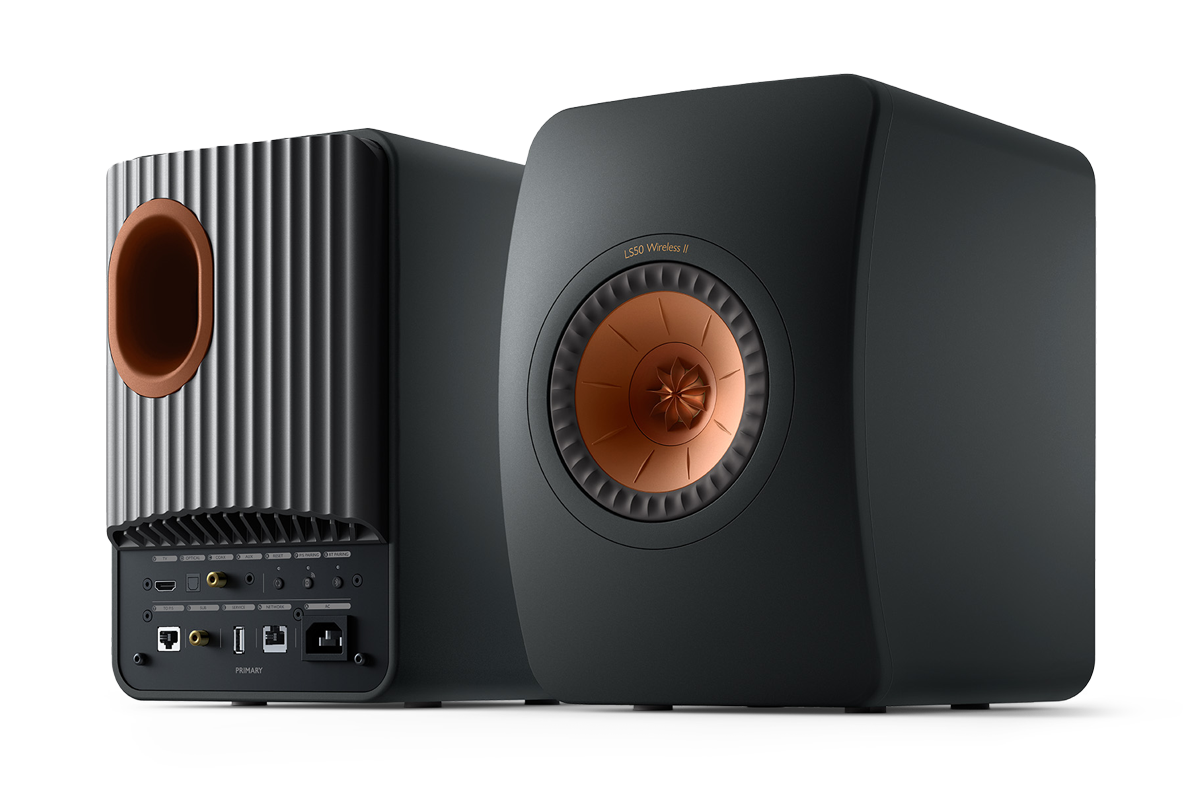
Its outer dimensions—12″H × 7.9″W × 12.2″D—are about the same as the LS50 Wireless, and just a smidgen larger than the LS50 and LS50 Meta. The primary speaker, which houses all the connectors and control circuitry, weighs 22.2 pounds; the secondary speaker weighs 20 pounds. By default, the primary speaker is used for the right channel, but you can change this setting in the Speaker Preferences menu of the companion KEF Connect app.
The LS50WII has the same 12th-generation Uni-Q driver as the LS50 Meta. The biggest difference between that driver and the 11th-generation Uni-Q driver used in the original LS50 and LS50 Wireless is the tweeter’s Metamaterial Absorption Technology. A 3″ MAT disc at the rear of the tweeter contains 30 tubes of varying sizes and shapes that absorb the driver’s rearward sound energy, preventing it from being reflected by the enclosure’s interior surfaces and interfering with the tweeter’s frontward radiation.
Like the original LS50 Wireless, the LS50WII is an active design, with separate amplifiers for the midrange-woofer and tweeter, and a digital crossover. The amps are considerably more powerful in the new model: a 280W class-D amp for the midrange-woofer and a 100W class-AB amp for the tweeter. The amps were rated at 200W and 30W respectively in the LS50 Wireless. In the LS50WII, the midrange-woofer is crossed to the tweeter at 1.9kHz.
As well as providing the digital crossover, the LS50WII’s digital signal processor (DSP) implements KEF’s Music Integrity Engine—a set of customized DSP functions, including phase correction, dynamic equalization, and room compensation—controllable by the KEF Connect app. I’ll explain these settings in more detail in the setup and software section.
Together with the active design, DSP enables the LS50WII to play more loudly and more deeply than an otherwise similar passive speaker. KEF quotes a maximum SPL at 1m of 108dB for the LS50WII, but a value of 106dB for the LS50 Meta, which has an identical driver and enclosure design. Specified frequency response of the LS50WII in Standard bass mode is 48Hz–28kHz, ±3dB. For the LS50 Meta, it’s 79Hz–28kHz, ±3dB.
Connect and control
On the LS50 Wireless, the primary and secondary speakers had to be linked with an Ethernet cable, which carried up to 24-bit/192kHz PCM audio. With the LS50 Wireless II, the primary and secondary speakers can be linked wirelessly. They’re paired at the factory, so you don’t have to worry about this in setup. You can also hardwire the primary and secondary speaker by running the supplied 3m (9.8′) Ethernet cable between the P/S (primary/secondary) ports on the speakers’ back panels. The LS50WII supports 24/96 audio with a wireless link, and 24/192 when hardwired.
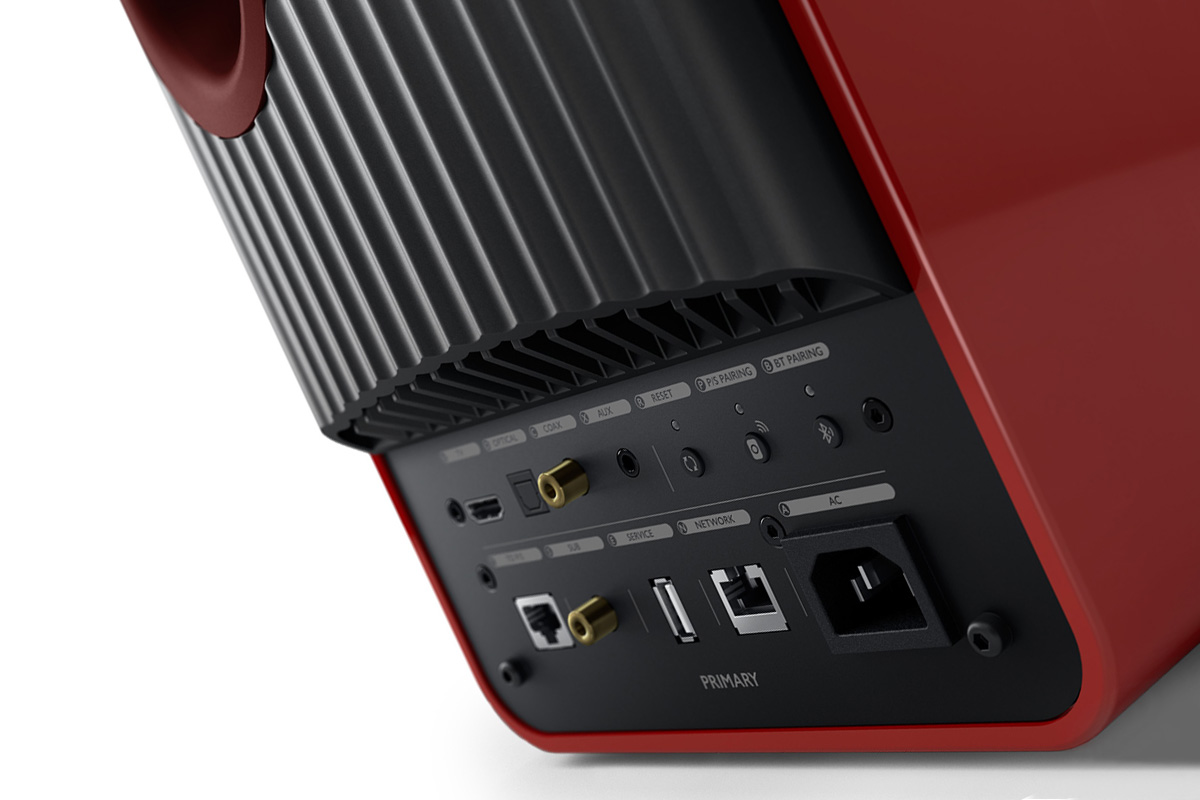
All the inputs are on the back of the primary speaker, which also houses the Bluetooth and Wi-Fi circuitry. Unlike the original LS50 Wireless, the LS50WII does not have a USB Type-B port for connecting a computer. At the top left of the jack panel is an HDMI eARC port, labeled TV, and to its right a TosLink input, a coaxial S/PDIF input, and a 1/8″ stereo analog input. To their right are buttons for factory reset, re-pairing the primary and secondary speakers, and Bluetooth pairing. On the second row are the P/S port, a subwoofer output jack (female RCA), a USB Type-A port for service, an Ethernet port for connecting a router, and a three-prong IEC power inlet.
From left to right on the back of the secondary speaker are the P/S port, subwoofer output jack, USB service port, P/S pairing button, and IEC power inlet.
For controlling the LS50WII, you can use the touch panel on the top of the primary speaker, the supplied remote control, or the KEF Connect app. The touch panel has five buttons, for power/standby, cycling through inputs, mute, volume down, and volume up. Above those buttons are indicator lights that show the active input: Wi-Fi, Bluetooth, TV (HDMI eARC), optical, coaxial, or auxiliary (1/8″ analog).
The remote has power and mute buttons at the top, and below that a four-way selector button with volume and source scrolling functions. At the bottom are three buttons for skipping, pausing, and resuming tracks during network and Bluetooth playback.
However, most interactions with the LS50WII will likely be done with the companion app, which has received a major refresh. The first-generation LS50 Wireless had separate apps for setup and music playback: KEF Control and KEF Stream. For the LS50WII, setup, control, and music playback are integrated into a single app: KEF Connect.
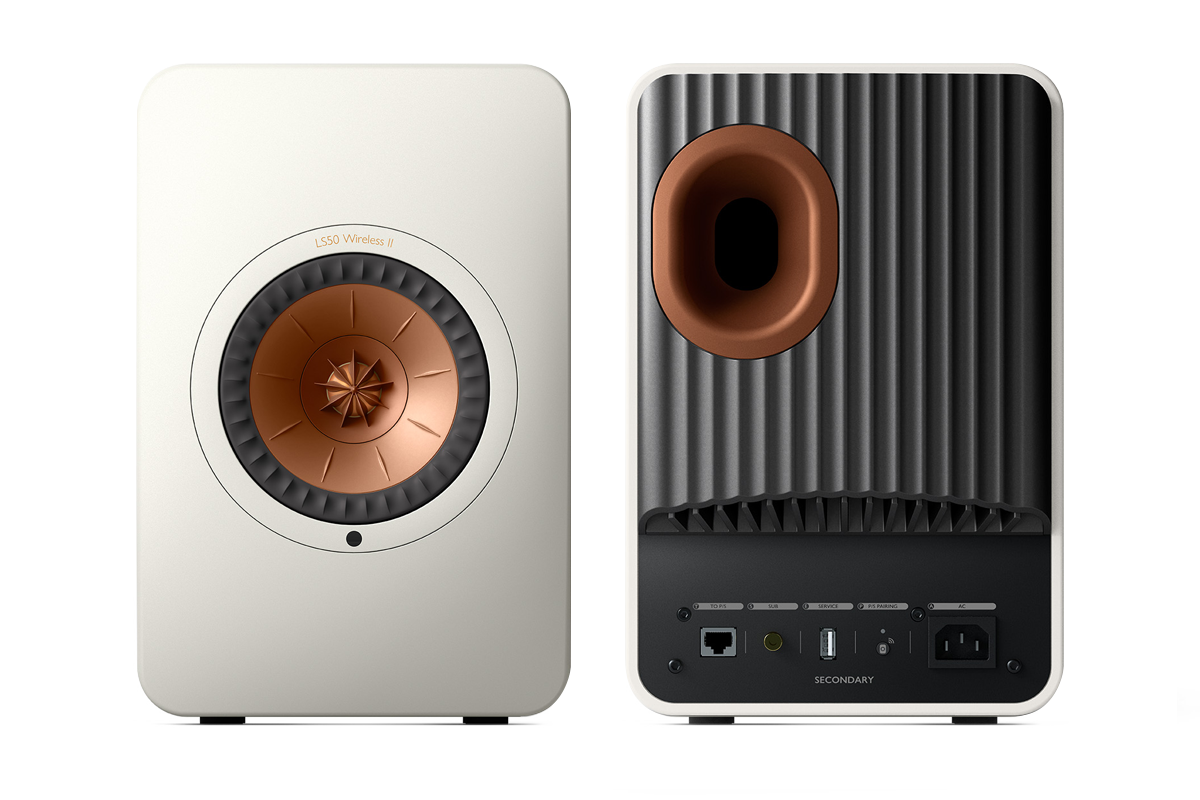
KEF Stream only supported three streaming services: Spotify, Tidal, and QQ Music (a streaming service popular in China). You could also stream music stored on your phone. All of that is possible with the LS50WII’s KEF Connect app, but KEF has also integrated support for Amazon Music, Deezer, and Qobuz. The LS50WII supports Apple AirPlay 2 and Chromecast Built-in, neither of which was available on the original. The LS50WII is Roon Ready (the original was Roon Tested). The LS50W had Spotify Connect, so you could stream to it from the Spotify app. The LS50WII adds Tidal Connect and QPlay, so you can also stream direct to the speaker from Tidal’s and QQ Music’s apps.
Unlike the original LS50 Wireless, the LS50WII can perform MQA Core decoding, so Tidal subscribers can play Masters content at up to 24/96 resolution. KEF has also added DSD support, and the LS50WII can accept up to DSD256 via its network inputs. Maximum source resolution of the LS50WII is 32/384 PCM and DSD256 via Wi-Fi and Ethernet, 24/96 via TosLink, and 24/192 via coaxial S/PDIF. All audio streams are converted to 24/96 PCM if the two speakers are paired wirelessly, or 24/192 if a wired connection is used between their P/S ports.
Setup and software
I placed the KEF LS50 Wireless IIs atop 28″-high Monoprice Monolith speaker stands on either side of the electric fireplace in the main-floor living room of our 1920s rowhouse. In that position, they were 7′ apart, 7′ from the sweet spot on the end cushion of our sectional sofa on the opposite wall. Their back panels were 16″ from the wall behind them.
The LS50WII comes with the most rudimentary Quick Start Guide I’ve ever seen. Three diagrams instruct you to connect the speakers to power outputs, wait for the Wi-Fi icon on the primary speaker to flash white and red, and download the KEF Connect app from Apple’s App Store or Google Play. That’s it.
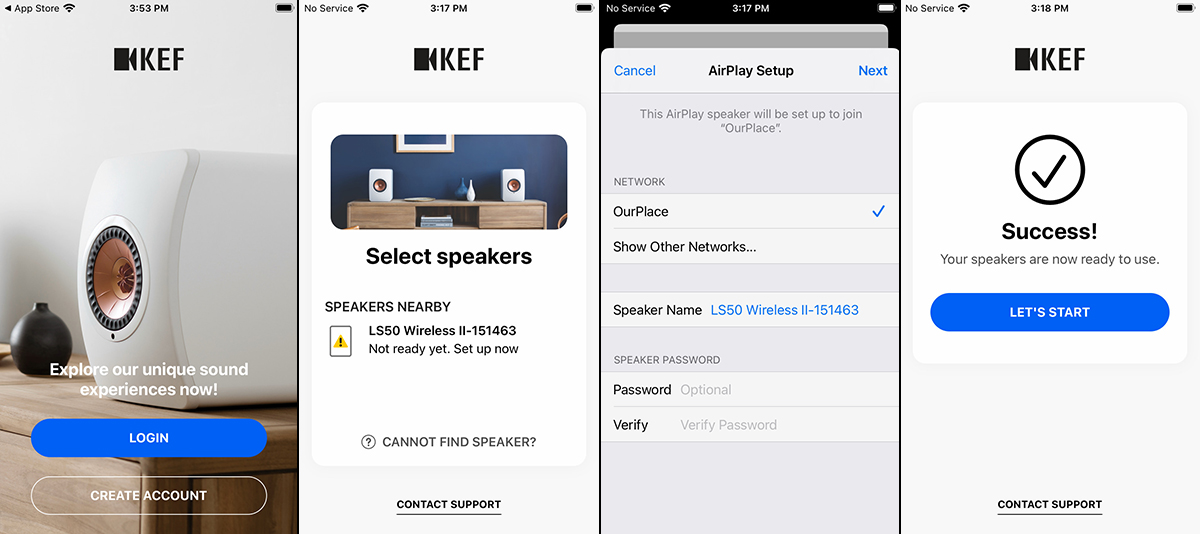
Fortunately, the Android and iOS versions of KEF Connect are both well designed. I think virtually all users will be able to get up and running by following the app’s guidance. But I also think it’s worth downloading the 98-page User Manual, as it contains lots of useful information on setup and day-to-day use.
For setup, the iOS and Android versions of KEF Connect work differently. I tried both, and they worked exactly as I expected. Both versions of the app prompt you to set up a user account with KEF, and then confirm which speaker you want to set up. After that, the iOS version asks you to confirm the name of your Wi-Fi network, and then uploads that information to the primary speaker. That’s it.
The Android version is more fiddly, but only a bit. It prompts you to download and open the Google Home app to perform the setup there. After Google Home finds the LS50WII, it prompts you to confirm the room where it’s being used, the name of your Wi-Fi network, and whether you want to use the Wi-Fi password stored on your device. After you answer a boilerplate privacy question, your settings are uploaded to the primary speaker.
For day-to-day use, the iOS and Android versions of KEF Connect work identically. You can use the app to adjust volume, select sources, skip tracks, choose music from streaming services, and adjust audio settings like EQ. I found the app well designed and straightforward to use.
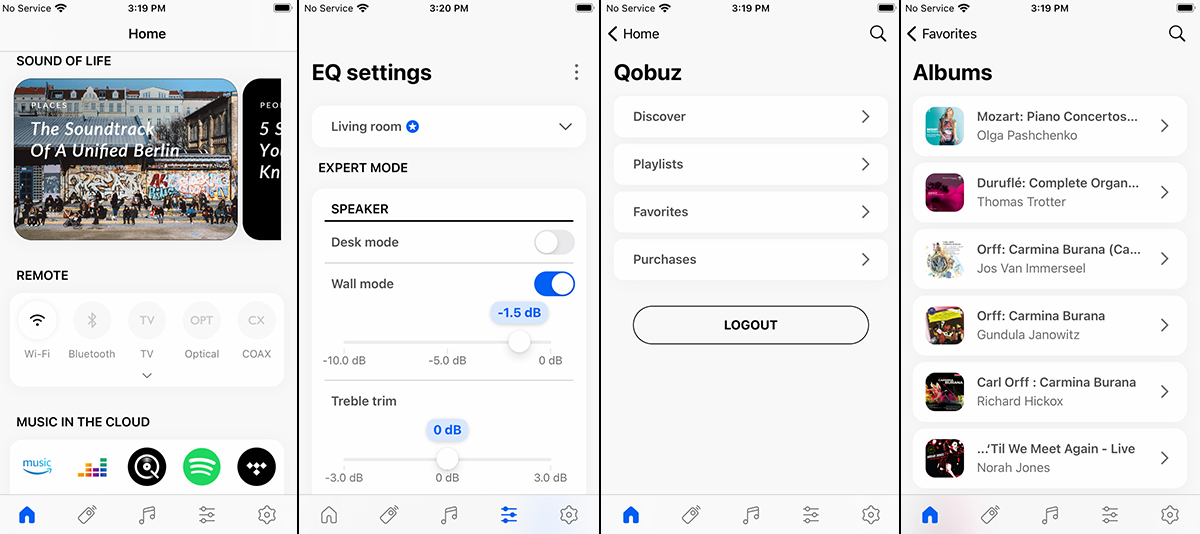
For EQ settings, you can choose Normal or Expert mode. In Normal mode, the app presents a series of prompts: whether you’re placing the speakers on stands or a desk; the distance to the wall (and the distance to the edge of the table if they’re on a desk); your room characteristics (Damped, Moderate, or Lively); the size of your room; and if you’re using a sub. The app then creates a profile of DSP settings that can be saved and applied to the speakers to suit your application.
Expert mode allows finer adjustments. You can specify the amount of bass trim in Wall mode, and presence in Desk mode; treble trim for room damping; turn phase correction on and off (it’s on by default); choose the bass extension setting (Less, Standard, Extra); and adjust low- and high-pass filter frequencies, gain, and polarity if you’re using a sub (there are also presets for many KEF subwoofers). I used the Normal mode for setup. I selected stand mounting and set the slider that indicates the distance to the wall at around 40cm (the slider scale is metric and not very precise), and chose the Standard bass extension setting.
For watching TV and movies, I connected the primary LS50WII’s HDMI eARC input to the HDMI ARC port on the One Connect set-top box for my 55″ Samsung Frame TV. Weirdness ensued. When I selected the TV input on the LS50WII, the sound kept coming out of the Frame TV’s built-in speakers—there was no sound at all through the KEF speakers. The Receiver (HDMI) option did not even appear in the Frame TV’s Sound Output menu. If I selected the optical input on the touch panel of the LS50WII, and then called up the Sound Output menu on the Frame TV, the Receiver (HDMI) option would reappear. When I selected that option, audio would momentarily shift to the KEF speakers, then revert to the TV. And once again, the Receiver (HDMI) option would no longer be present on the Frame TV’s Sound Output menu. Go figure!
I raised the issue with KEF, and the company responded: “This is a known issue with Samsung in general. . . . they don’t play nice with many external audio sources. Our engineers are trying to work closer with their development team to see how we can offer better UI in the future. Meanwhile our customers who have had the same issue use the Optical input. However you will no longer be able to control the speaker volume through the Samsung remote. You’ll have to control it through the LS50WII remote. . . . It’s a shame because the user experience on pretty much every other TV is fabulous.” I’ve had problems getting the Frame TV’s HDMI ARC feature to work with many other (non-Samsung) components, so I agree it’s likely that Samsung is the culprit here. And I had no problem using the LS50WII’s HDMI eARC feature with the 50″ Vizio HDTV in our basement family room.
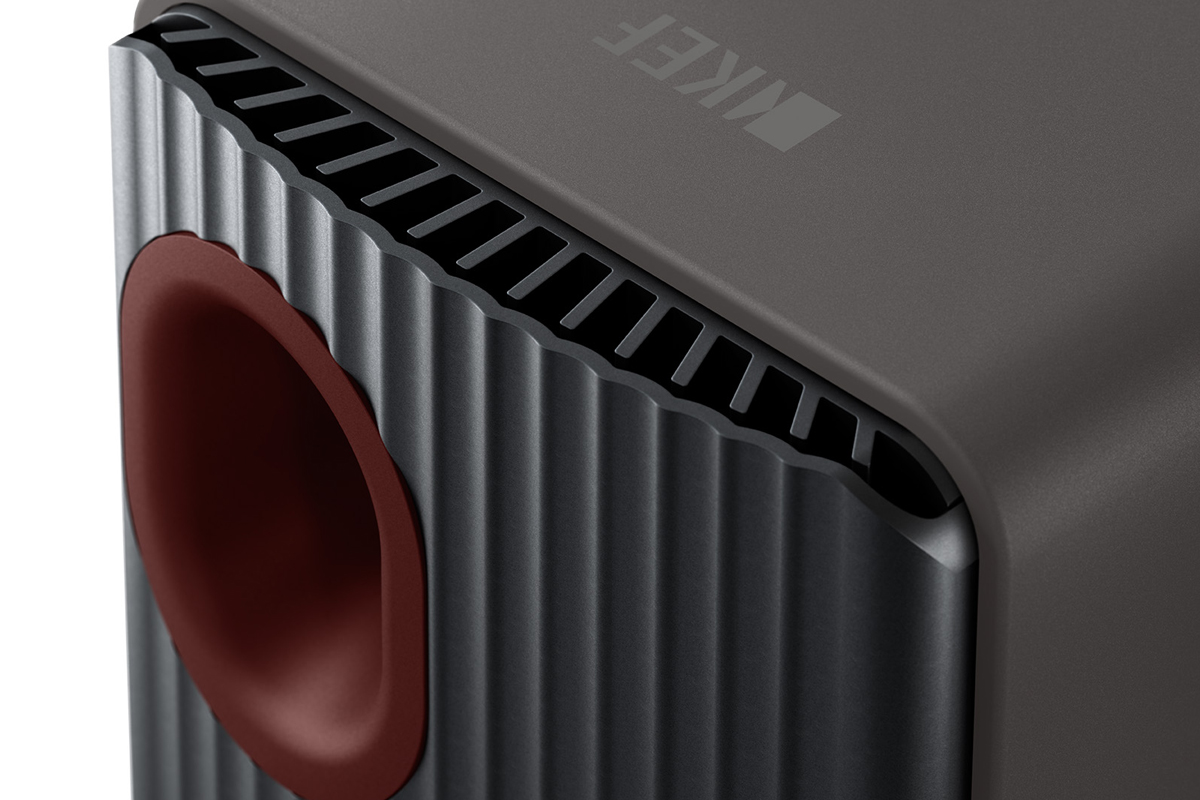
Per KEF’s suggestion, I used a TosLink optical connection to play audio from the Samsung Frame TV to the LS50WIIs, and it worked fine. According to KEF’s White Paper for the LS50WII, latency is less than 6msec with phase correction turned on and a wireless connection between the primary and secondary speakers, so “lip-syncing should not be a problem.” So it proved during my listening. Even on dialog-heavy content, video and audio seemed perfectly in sync.
Listening
I briefly streamed music to the LS50 Wireless IIs from my Apple iPhone 8 via AirPlay 2, and from my Google Pixel 4a 5G smartphone using Chromecast—both worked seamlessly. But for most of my listening, I streamed music from my music library using Roon, and from Qobuz using the KEF Connect app.
These little speakers exhibited all the virtues one expects from a pair of well-engineered minimonitors: commendable timbral accuracy with voices and instruments; fast, articulate sound; and a broad, deep soundstage with precisely focused aural images. But thanks to their active design and DSP functions, they exhibited virtues one rarely associates with minimonitors: surprisingly weighty bass, and thrilling dynamics.
Right from the beginning, I was blown away by the LS50WIIs’ rendering of a live recording of Carl Orff’s secular cantata Carmina Burana by the London Symphony Orchestra and Chorus, conducted by Richard Hickox (24-bit/96kHz FLAC, Chandos/Qobuz). The KEF minimonitors threw a huge soundstage—wide, deep, and tall—with excellent front-to-back layering.
In the dramatic opening to the iconic first movement, “O Fortuna,” a huge bass drum underpins the chorus lamenting the arbitrariness of fate (“O Fortune, like the moon, you are changeable, ever waxing and waning”). Those drum beats jumped out of the right side of the soundstage, without a hint of bloat. True, I’ve heard them sound deeper and more explosive through larger speakers. But for a pair of minimonitors with 5.25″ midrange-woofers, what the LS50WIIs did was amazing—those drumbeats sounded bold, dramatic, and superbly controlled. The KEFs clearly presented the impact of the mallets, followed by the reverberation of the drumbeats through London’s Barbican Centre. The big cymbal clashes in the center of the soundstage were effortless, with no hint of splashiness.
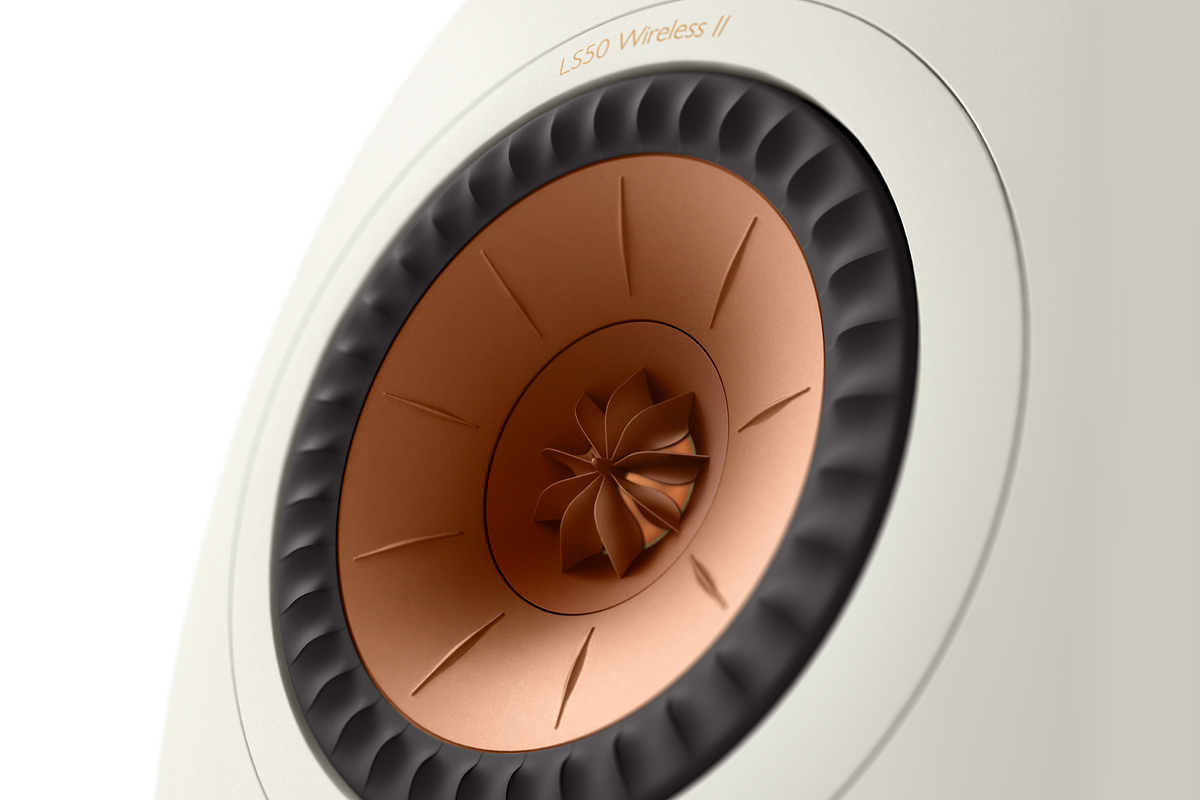
What most impressed me were the transparent textures and thrilling dynamics during the big wall-of-sound passages, with the orchestra and chorus going full tilt. I heard no evidence at all of congestion or compression.
The quieter section in the middle of the movement was pure magic. The spatial presentation was huge, but every element was clearly portrayed. I could easily follow the choir’s clipped Latin phrases, and the way their singing and the brass and percussion accompaniment decayed into the nearly 2000-seat concert hall.
The LS50WIIs showed their impressive bass chops in Christian McBride’s performance of Ornette Coleman’s “Blues Connotation” from The Q Sessions, a new EP where McBride teams up with guitarist Mike Stern, saxophonist Marcus Strickland, and drummer Eric Harland (24/192 FLAC, Mack Avenue/Qobuz). The track opens with a big double-bass riff played by McBride, and it sounded delicious through the little KEFs: deep, robust, taut, and tuneful. During McBride’s long solo in the middle of the track, I loved the sharp attack of staccato notes, and the big woody sound of the instrument’s soundbox.
But it wasn’t all about the bass. In Stern’s guitar solo, the KEF minimonitors followed his rapid runs wonderfully. Strickland’s alto-sax solo was anchored on the left side of the soundstage, with sharp toots segueing beautifully into long reedy notes. The squawks had fantastic bite. While kick-drum beats were a bit thuddy, everything else about Harland’s drum solo was fantastic. Floor toms had marvelous palpability, with the vibration of the drum head segueing into resonance of the drum body. Rim shots were explosive, and snare rolls beautifully articulated. Best of all was the way everything held together—through these little KEFs, the whole track just swung.
A wonderful recording of Philip Glass piano music by Icelandic pianist Víkingur Ólafsson (24/96 FLAC, Deutsche Grammophon/Qobuz) demonstrated the LS50WII’s ability to combine poetry with power. I loved the KEF minimonitors’ presentation of Ólafsson’s right-hand legato notes during the dreamy opening to Glass’s Étude No.2. These active stand-mounters made it easy to appreciate his subtly varied touch and his expressive use of the sustain pedal. And when Ólafsson played deep, pedaled left-hand notes—wow! Even though those notes were played softly, the LS50WIIs clearly conveyed the immense power of his Steinway grand piano. As the piece built and Ólafsson’s playing became more passionate, the LS50WIIs scaled up effortlessly. His attacks were fast, and decays went on forever. Throughout the whole piece, the piano tone was consistently gorgeous over the instrument’s entire range, with wonderful ringing clarity up top and satisfying weight down low. Again, the spatial presentation was superb. The little KEFs threw a huge soundstage that evoked the Harpa concert hall in Reykjavík, Iceland, where this recording was made.
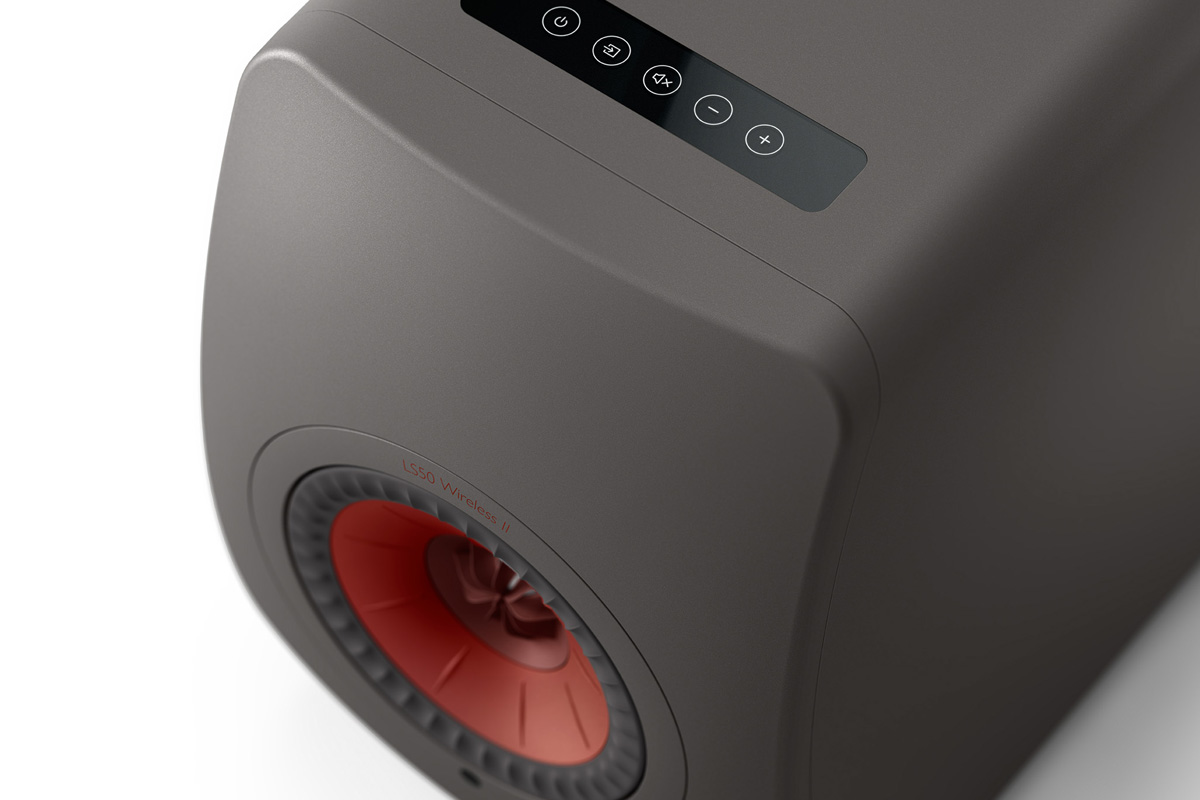
Later in the album, Ólafsson plays Christian Badzura’s arrangement for piano and string quartet of the same piece. The four players of the Siggi String Quartet were precisely located across the front of the soundstage, with Ólafsson’s Steinway behind them. The string tone was lovely. I could hear the action of the rosined bows on the strings, but the sound was never edgy or scratchy. The two violins had wonderful clarity, and the viola and cello sounded rich and woody.
On the anthemic title track of Jon Batiste’s We Are (24/44.1 FLAC, Verve/Qobuz), these active minimonitors sounded way bigger and more powerful than they had any right to. Batiste’s Fender Jazz Bass and the drums, credited to Nate Smith and Pomo, were explosive and superbly controlled. However, the Moog synth bass (also played by Batiste) on the right side of the soundstage sounded a little drone-ish and indistinct. The big choruses, with the Gospel Soul Children at the rear of the massive soundstage singing, “We are, we are, we are the golden ones / We are, we are, we are the chosen ones,” sounded huge—it was completely thrilling. I was awestruck by the way the LS50WIIs presented the big wall-of-sound moments late in the song, when the St. Augustine High School Marching 100 plays behind Batiste singing, “We are never alone,” and then later behind the choir singing the main chorus. The little KEFs presented all these elements with admirable clarity, and without a hint of distress.
Comparisons
I compared the LS50WII with two other DSP-powered active Wi-Fi loudspeakers: KEF’s original LS50 Wireless and Buchardt Audio’s A500 ($4150/pair in standard finishes, including shipping, duties, and applicable taxes.)
As I had done with the LS50WIIs, I placed the LS50 Wireless speakers atop my Monoprice Monolith stands. In the Basic setup section of the KEF Control app, I selected stand mounting, and a wall-to-speaker distance of 40cm (16″). As you’d expect, there was a clear family resemblance between the first- and second-generation LS50 Wireless speakers; but in areas like soundstaging, bass control and extension, and dynamics, the newer model outclassed the original.
Playing “O Fortuna” from Orff’s Carmina Burana, orchestral and choral textures weren’t as transparent on the original LS50 Wireless speakers. The soundstage was a little less deep and high, and the presentation less spacious. The diction of the choir didn’t sound as crisp. While still impressive, the big wall-of-sound passages sounded more congested and compressed through the first-generation KEFs, and also a tad harsher. The big bass-drum beats weren’t quite as deep or dramatic. The initial thwacks didn’t hit as hard, and I heard less of their reverberation through the Barbican Centre’s spacious concert hall.
On “Blues Connotation,” Christian McBride’s double bass sounded as big and robust through the first-generation KEFs, but the lower notes were a bit thuddier. McBride’s staccato notes were a tad less crisp, so that notes on his rapid-fire solo were a little less clearly differentiated. Similarly, Harland’s kick-drum beats sounded thuddier, and his rim shots and floor-tom beats didn’t hit quite as hard. His cymbals and bells had a tad less sheen, and the attacks of Strickland’s alto sax had a bit less bite and squawk. The biggest difference was the soundstage, which was more confined in both height and depth. Placement of aural images was a little more precise with the newer Wireless IIs.
The Buchardt A500 is a sealed design with front- and rear-mounted 6″ midrange-woofers and a 0.74″ soft-dome tweeter; each driver is powered by its own class-D amplifier, specified to output 150W RMS. While a pair of A500s can be used on its own, the speakers are really intended to be used with the companion Stereo Hub WiSA transmitter; Buchardt offers a bundle comprising a pair of A500s and a Stereo Hub in standard finishes for $4450.
The A500 has an unusual feature that Buchardt calls Mastertuning, which allows users to change crossover parameters and other DSP functions. For this comparison, I used an updated version of the stock 2.5-way Mastertuning.
The A500s created an even larger soundstage than the LS50WIIs, with more precise imaging. The bass was deeper and better controlled. The KEFs sounded warmer and rounder, but the Buchardts were faster and more articulate.
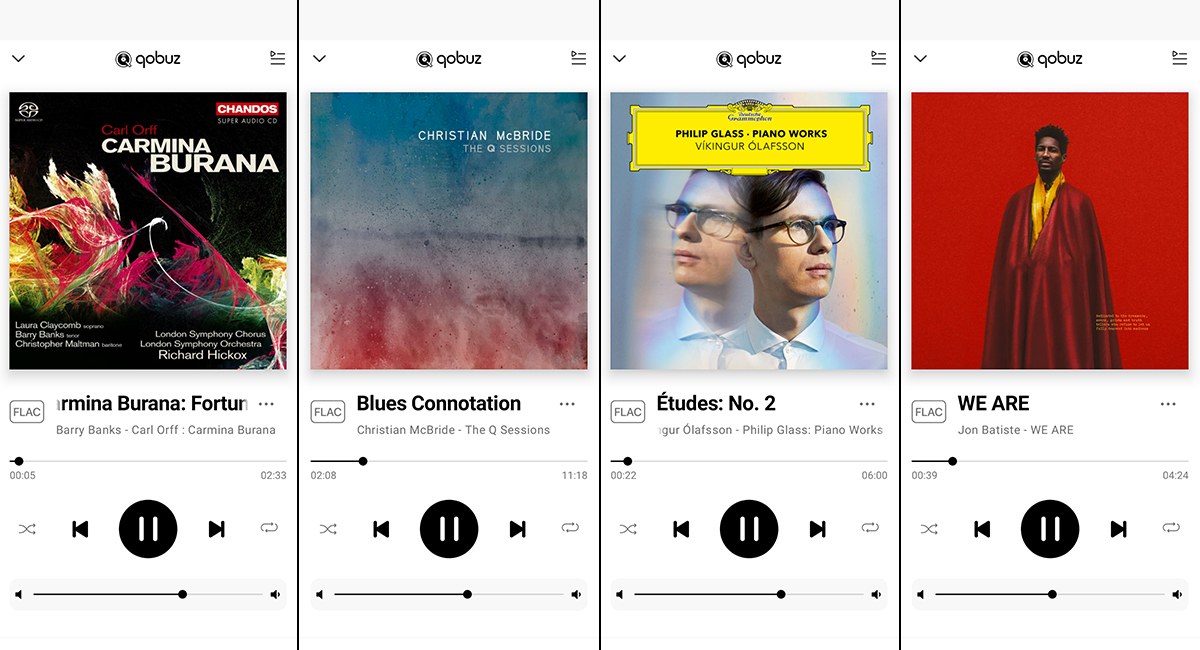
In Philip Glass’s Étude No.2, Víkingur Ólafsson’s piano attacks were slightly crisper through the A500s, and more clearly differentiated from the sustains and decays that followed. Piano tone was fuller on the LS50WIIs, but clearer and more bell-like on the A500s. The deep left-hand notes were better defined on the Buchardts, but richer and more resonant on the KEFs. While both sets of speakers conveyed the power of Ólafsson’s Steinway wonderfully, the A500s executed sudden dynamic shifts more readily.
In Christian Badzura’s arrangement of the étude, the aural image of the Siggi String Quartet’s four players across the front of the soundstage was even more precise through the A500s. The violins, viola, and cello sounded lusher through the LS50WIIs, a little leaner through the A500s—though never wiry. The high notes on the two violins soared a little more through the A500s. The players’ bowing was a little clearer on the A500s, so that it sounded more expressive—but never scrapey. By a narrow margin, I preferred the way the A500s reproduced this piece—both Glass’s original solo piano version, and Badzura’s ensemble arrangement.
On Jon Batiste’s “We Are,” the A500s created a soundstage that was wider, but less deep. The Gospel Soul Children’s big choruses were slightly more transparent, and Batiste’s Fender bass guitar and Moog bass were better controlled through the A500s. The big wall-of-sound sections late in the song were more clearly resolved through the A500s, so that it was easier to follow individual elements. But the brass instruments and the soprano and alto voices sounded a bit harder than they did through the LS50WIIs. So did Batiste’s voice, as he belted out, “We are never alone.” The fact is, both pairs of speakers sounded wonderful on this fantastic song. If I had to pick a preference, I’d go with the A500s, but only by a tiny margin.
Conclusion
I find these comparisons very telling. Sonically, the LS50 Wireless II is a significant upgrade over the first-generation LS50 Wireless, a SoundStage! Network Product of the Year winner. And functionally, the LS50WII is a massive upgrade over its predecessor.
The LS50 Wireless II also holds its own against the Buchardt A500/Stereo Hub combination, which also won a SoundStage! Network Product of the Year award. The Buchardt bundle costs $1951 more than a pair of LS50WIIs.
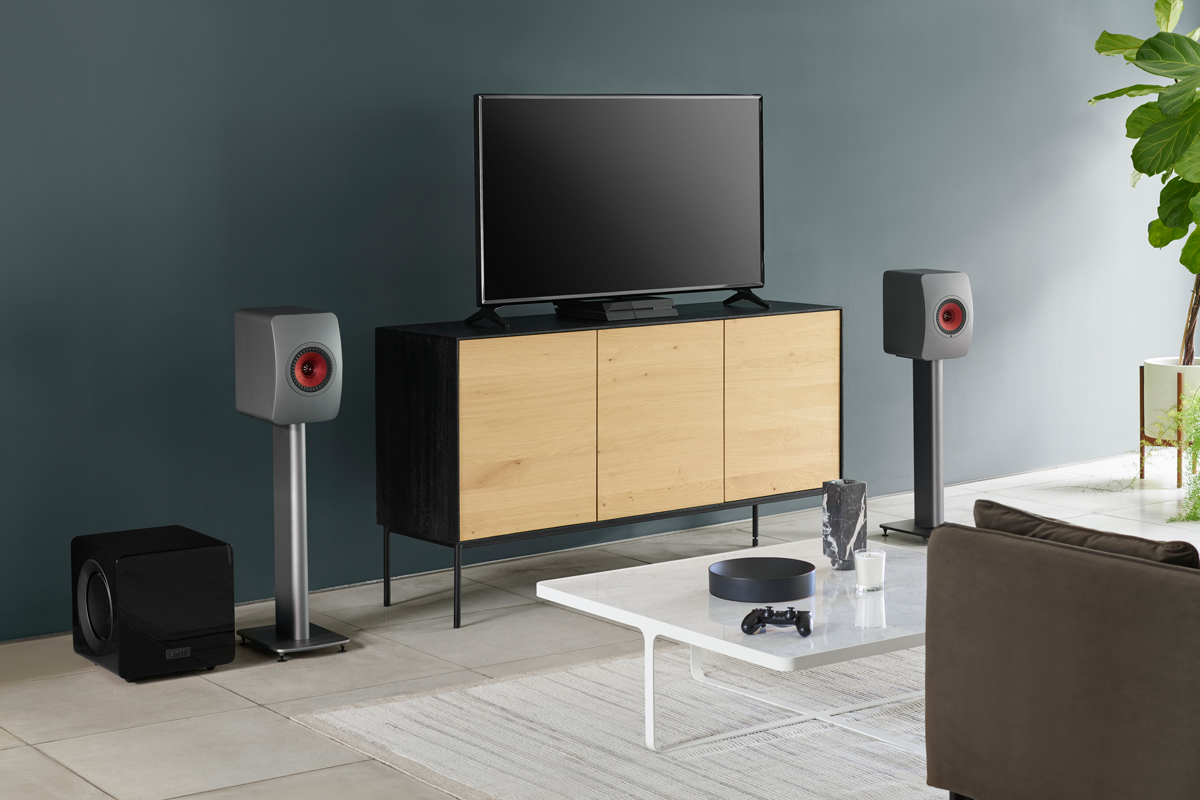
Like the LS50 before it, KEF’s passive LS50 Meta has been praised for its stellar performance and value for money. As Doug Schneider stated in his review, “the LS50 Meta can hold its own against stand-mounted speakers of any price. That’s what made the original model such a hit from the moment of its release, and it will probably guarantee this latest version similar success.”
For $1000 more than the Meta, the LS50 Wireless II adds built-in amplifiers with 760W total output, preamp functions, a high-resolution DAC, and a very capable network streamer. Not only is KEF’s LS50 Wireless II a standout performer in its own right, it’s also an incredible value. I think it’s the best deal in hi-fi right now.
. . . Gordon Brockhouse
Associated Equipment
- Active loudspeakers: KEF LS50 Wireless, Buchardt Audio A500 with Stereo Hub.
- Sources and control devices: Apple iPhone 8 and Google Pixel 4a 5G smartphones; Apple Mac Mini computer running Roon Core 1.8; Samsung UN55LS003 HDTV “The Frame”; Vizio D50-D1 HDTV.
- Network: Google Wifi four-point mesh network.
KEF LS50 Wireless II Active Loudspeakers
Price: $2499 USD per pair.
Warranty: Five years parts and labor; active electronics, one year.
KEF
GP Acoustics (UK) Ltd.
Eccleston Road, Tovil
Maidstone
Kent ME15 6QP
United Kingdom
Phone: +44 (0)1622-672261
Fax: +44 (0)1622-750653
E-mail:
Website: www.kef.com
North America:
KEF
GP Acoustics (US) Ltd.
10 Timber Lane
Marlboro, NJ 07746
United States
Phone: (732) 683-2356
Fax: (732) 683-2358
E-mail:
Website: www.kef.com/us



